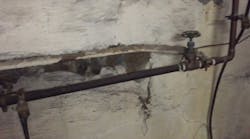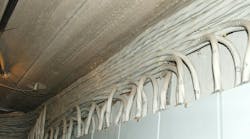Now That's What I Call a “Git-R-Done” Job
There's no doubt this installation would make Larry the Cable Guy proud. Holy smokes! Although there is no electrical Code violation present in this photo, the persons responsible for this travesty fail to comply with the common sense clause that comes with joining the human race. But hey, at least it looks like they had a Boy Scout or sailor tie the knots on the rope.
While this installation might cause you to laugh initially, that feeling is soon replaced by concern and fear for the person who has to climb up this ridiculous work platform. Because electrical installers and maintenance personnel are often required to work in the overhead space of high-bay commercial occupancies or outside on lighting poles, this photo should cause everyone to reflect on the methods and procedures they use when working aloft.
Are you considering all pertinent Occupational Safety and Health Administration (OSHA) regulations related to such activities? Do you have the requisite equipment, such as harnesses, lifts, or ladders at your disposal (when appropriate)? Have your employees been trained on the proper use of such equipment? Have you documented such training? Can you prove your employees are qualified personnel?
Take the time to look into this matter and ensure you're conducting work aloft in a safe and secure manner. Then say a prayer for the guy who has to climb this monstrosity.
More Than Just a Bathroom
That's the thought that occurred to me when I first saw the Photo on page 37. Call me old-fashioned, but I thought bathrooms were meant to enclose indoor plumbing and bathing facilities. It appears somewhere along the way, this bathroom evolved into something completely different.
The installation of chandeliers, TVs, audio systems, and telephones has moved beyond the living and dining rooms and become commonplace in many bathrooms. While I consider the addition of such amenities in a bathroom as interior design “run amok,” the installation of such equipment is permitted but also regulated by the NEC.
Here, we see an obvious violation of the rule given in 410.10(D). The first two sentences of this section state, “No parts of cord-connected luminaires, chain-, cable-, or cord-suspended luminaires, lighting track, pendants, or ceiling-suspended (paddle) fans shall be located within a zone measured 900 mm (3 ft) horizontally and 2.5 m (8 ft) vertically from the top of the bathtub rim or shower stall threshold. This zone is all encompassing and includes the space directly over the tub or shower stall.”
Those two sentences define the area around a bathtub or shower stall from which hanging fixtures are excluded. There may be no such hanging fixture within 8 ft of the maximum water level — and that exclusion zone extends for 3 ft on all sides of the tub. Where ceiling heights permit compliance with the established limits of the exclusion zone, hanging fixtures and ceiling fans are permitted. Where ceiling heights do not allow for hanging fixtures, surface-mounted or recessed fixtures (better yet) may be used to provide overhead illumination for shower stalls and bathtubs. As noted in the last sentence of 410.10(D), where surface-mounted or recessed fixtures are located less than 8 ft above the maximum water level, they must be listed for damp locations, unless subject to direct shower spray, in which case, the fixtures would have to be listed for wet locations.





